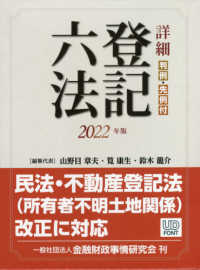- ホーム
- > 洋書
- > 英文書
- > Nature / Ecology
基本説明
Graduate Textbook.
Full Description
Integrated Pest Management (IPM) is an effective and environmentally sensitive approach to pest management. It uses natural predators, pest-resistant plants, and other methods to preserve a healthy environment in an effort to decrease reliance on harmful pesticides. Featuring forty chapters written by leading experts, this textbook covers a broad and comprehensive range of topics in integrated pest management, focused primarily on theory and concepts. It is complemented by two award winning websites, which are regularly updated and emphasize specific IPM tactics, their application, and IPM case studies: Radcliffe's IPM World Textbook - http://ipmworld.umn.edu VegEdge - www.vegedge.umn.edu The two products are fully cross-referenced and form a unique and highly valuable resource. Written with an international audience in mind, this text is suitable for advanced undergraduate and graduate courses on Integrated Pest Management, Insect or Arthropod Pest Management. It is also a valuable resource for researchers, extension specialists and IPM practitioners worldwide.
Contents
1. The IPM paradigm: concepts, strategies and tactics Michael E. Gray, Susan T. Ratcliffe and Marlin E. Rice; 2. Economic impacts of IPM Scott M. Swinton and George W. Norton; 3. Economic decision rules for IPM Leon G. Higley and Robert K. D. Peterson; 4. Decision making and economic risk in IPM Paul D. Mitchell and William D. Hutchison; 5. IPM as applied ecology: the biological precepts David J. Horn; 6. Population dynamics and species interactions William E. Snyder and Anthony R. Ives; 7. Sampling for detection, estimation and IPM decision making Roger D. Moon and L. T. Wilson; 8. Application of aerobiology to IPM Scott A. Isard, David A. Mortensen, Shelby J. Fleischer and Erick D. De Wolf; 9. Introduction and augmentation of biological control agents Robert J. O'Neil and John J. Obrycki; 10. Crop diversification strategies for pest regulation in IPM systems Miguel A. Altieri, Clara I. Nicholls and Luigi Ponti; 11. Manipulation of pathogenic microorganisms for IPM of arthropod pests Stephen P. Wraight and Ann E. Hajek; 12. Integrating conservation biological control into IPM systems Mary Gardiner, Anna Fiedler, Alejandro C. Costamagna and Douglas A. Landis; 13. Barriers to adoption of biological control agents and biological pesticides Pamela G. Marrone; 14. Integrating pesticides with biotic and biological control for arthropod pest management Richard A. Weinzierl; 15. Pesticide resistance management Casey W. Hoy; 16. Assessing environmental risks of pesticides Paul C. Jepson; 17. Assessing pesticide risks to humans: putting science into practice Brian Hughes, Larry G. Olsen and Fred Whitford; 18. Advances in breeding for host plant resistance C. Michael Smith; 19. Resistance management to transgenic insecticidal plants Anthony M. Shelton and J. Z. Zhao; 20. Role of biotechnology in sustainable agriculture Jarrad R. Prasifka, Richard L. Hellmich and Michael J. Weiss; 21. Use of pheromones in IPM Thomas C. Baker; 22. Insect endocrinology and hormone-based pest control products in IPM Daniel Doucet, Michel Cusson and Arthur Retnakaran; 23. Eradication - strategies and tactics Michelle L. Walters, Ron Sequeira, Robert Staten, Osama El-Lissy and Nathan Moses-Gonzales; 24. Insect management with physical methods in pre- and post harvest situations Charles Vincent, Phyllis G. Weintraub, Guy J. Hallman and Francis Fleurat-Lessard; 25. Cotton arthropod IPM Steven E. Naranjo and Randall G. Luttrell; 26. Citrus IPM Richard F. Lee; 27. IPM in greenhouse vegetables and ornamentals Joop C. van Lenteren; 28. Seed potato IPM Jeffrey A. Davis, Edward B. Radcliffe, David W. Ragsdale and Willem Schrage; 29. IPM in structural habitats Stephen A. Kells; 30. Fire ant IPM David H. Oi and Bastiaan M. Drees; 31. Integrated vector management for malaria Chris F. Curtis; 32. Gypsy moth IPM Michael L. McManus and Andrew M. Liebhold; 33. IPM for invasive species Robert C. Venette and Robert L. Koch; 34. IPM information technology John K. VanDyk; 35. Private-sector roles in advancing IPM adoption Thomas A. Green; 36. IPM, ideals and realities in developing countries Stephen Morse; 37. The USA National IPM Roadmap Harold D. Coble and Eldon E. Ortman; 38. The role of assessment and evaluation in IPM implementation Carol L. Pilcher and Edwin G. Rajotte; 39. From integrated pesticide management to organic and sustainable agriculture John Aselage and Donn T. Johnson; 40. Future of IPM, a worldwide perspective E. A. Heinrichs, Karim M. Maredia and Subbarayalu Mohankumar; Index.







